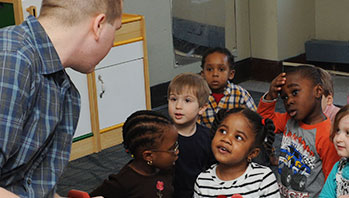- chart paper
- marker
- listen
- loud
- sound
- source
- whisper
MA Standards:
Speaking and Listening/SL.PK.MA.1: Participate in collaborative conversations with diverse partners during daily routines and play.
Language/L.PK.MA.1: Demonstrate use of oral language in informal everyday activities.
Head Start Outcomes:
Language Development/Receptive Language: Attends to language during conversations, songs, stories, or other learning experiences.
Language Development/Expressive Language: Uses language to express ideas and needs.
PreK Learning Guidelines:
English Language Arts/Language 2: Participate actively in discussions, listen to the ideas of others, and ask and answer relevant questions.
Science and Technology/Living Things and Their Environment 15: Use their senses of sight, hearing, touch, smell, and taste to explore their environment using sensory vocabulary.
Talk Together: Talk About Sound

© Commonwealth of Massachusetts, Department of Early Education and Care (Jennifer Waddell photographer). All rights reserved.
STEM Key Concepts: Sounds have a source; Sounds vary in three ways: volume, pitch, and timbre
ELA Focus Skills: Speaking and Listening, Vocabulary
Begin the lesson by making a loud clap with your hands. Say, I just made a loud clapping sound. How did I make the sound?
Explain to children that every sound they hear has a source or an object that makes the sound and that the source of the clapping sound is your hands. Say,
- Let me hear you make the same sound.
- Ask children to think of some other loud sounds they can make. (stamping feet, whistling)
Next, lower your voice to a whisper and ask children to sit quietly and close their eyes. Encourage them to listen to the sounds around them. After one minute ask questions such as,
- What sounds do you hear? Are they loud or quiet?
- What do you think was making that sound?
- Can you tell where the sounds came from? Were they indoor or outdoor sounds?
- Encourage children to close their eyes and listen for another minute. Then ask, Did you hear any new sounds? Let’s try to imitate that sound.
Have children dictate or draw their responses on chart paper. Label the chart “Sounds We Hear.”
Explain to children that listening for sounds helps them to learn about the world around them. Encourage them to listen to sounds throughout the day when they are outside or inside, and at different times of day. Prompt them to add to the chart as they observe interesting sounds.
Educator Tip: Children may respond to questions with misconceptions about sound. Guide their understanding by turning their misconception into a question about sound. For example, if a child responds that the loud sound was coming from something “big,” say, Do loud sounds always come from big things? Or can small things make loud sounds, too?
